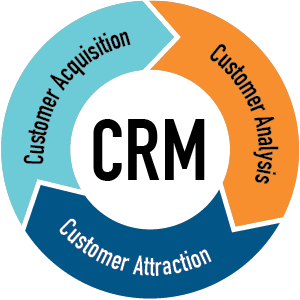Sales lead generation is a vital part of Customer Relationship Management (CRM) systems, where software is used to organize, automate and link all interactions with customers. This has become increasingly important with the emergence of the Internet. More customers are doing product research online and communicating via email and posting website inquiries to dealers about the products they’re interested in before ever setting foot in a dealership.
 Farm Equipment spoke with Scott McCrea, president of ETech Innovation Group, who is developing a lead distribution and response system for dealers and manufacturers. He has designed the system specifically for the ag industry by combining his shortline equipment background with 13 years of experience in automotive industry lead management systems. He says dealers (including those who are using CRMs) are having trouble managing their responses to leads. McCrea has done numerous case studies on roughly 120 dealerships, testing their response rates to email and Web-based customer leads. Here, he discusses with us what he’s found.
Farm Equipment spoke with Scott McCrea, president of ETech Innovation Group, who is developing a lead distribution and response system for dealers and manufacturers. He has designed the system specifically for the ag industry by combining his shortline equipment background with 13 years of experience in automotive industry lead management systems. He says dealers (including those who are using CRMs) are having trouble managing their responses to leads. McCrea has done numerous case studies on roughly 120 dealerships, testing their response rates to email and Web-based customer leads. Here, he discusses with us what he’s found.
How are dealers currently handling inquiries?
“A farm equipment dealership can be receiving leads from 18 different sources at any given time, which adds to the overall complexity of their problem. Some have a CRM to help manage these leads, and others don’t. It is estimated that a CRM is in place and active in less than 20% of dealerships. For those with a CRM program, in most cases, the lead is entered manually into the program and the customer awaits a response. It can often be difficult and cost prohibitive to integrate all the different lead types into one CRM. It’s cumbersome and it causes problems, as not all leads can be tracked using one system.
“Other dealerships manage leads in Outlook or a similar mail client. Managing leads in a mail system is a recipe for failure in almost every case, as they get lost in the shuffle. There is no tracking or reporting on performance and very little ability for management to monitor the process.”
How are dealers performing in their response to these leads?
“Overall, the average farm equipment dealership responds to 50-60% of all leads received by email. The poorest average performance came from a larger dealer group that only responded to 30% of the leads submitted on its website.
“If you’re only responding to 30% of your leads, that’s 70% of your potential opportunity that you are missing out on. If you’re trying to fill the top of a funnel and you’re ignoring 70% of what’s coming in to it, you’re at a strong disadvantage right out of the gate.
“My studies show that the average response time for sales staff who respond to inquiries is 4 hours and 42 minutes. About 94% of all responses come within 33 hours of receiving the lead, indicating that if leads aren’t responded to initially, they will never be responded to.
 “When a customer walks in the front door of a dealership, there are 4 or 5 potential people waiting to greet them. When a customer inquires by email, it is forwarded to a sales manager and then to a sales person who usually responds when they get around to it. Emails are not given priority because most dealerships don’t currently have the infrastructure to make them a priority.”
“When a customer walks in the front door of a dealership, there are 4 or 5 potential people waiting to greet them. When a customer inquires by email, it is forwarded to a sales manager and then to a sales person who usually responds when they get around to it. Emails are not given priority because most dealerships don’t currently have the infrastructure to make them a priority.”
What does it mean for the dealership if they have a low response rate?
“No one in a buying mindset likes to be ignored. This customer abandonment means a poor experience for their potential customer, which will undoubtedly have an effect on the dealership’s bottom line. Every lead is very important, especially in the ag industry. Due to the high transaction value of farm equipment, each lead has a measurable return to the dealership.
“I believe dealerships’ management of shortline equipment leads will be the most impacted by the low response rate. The main reason for this is that the customer is less likely to have an existing relationship with the closest shortline dealership for the product they are interested in. In this case, the customer is most likely to abandon the dealership, resulting in the loss of the sale.
“If a customer is looking for equipment from a mainline OEM, they may have no choice but to continue to work with the same dealership, as the next closest dealer may be too far away. But the dealership still risks losing the sale as the lead looks to another more responsive dealership that offers a similar product from another manufacturer.”
Why are dealers’ responses to inquiries so low?
“In most cases, the dealerships are not aware they are underperforming. They have no way to monitor and report on their performance.
|
|
“Dealers are also facing new challenges today as their customer expectations are changing. These same customers are receiving high levels of service from other industries, raising their overall service expectations. There has been very little formalized discussion on the topic of lead management for ag equipment dealers and OEMs. As with anything new, there is a learning curve. In the case where a dealership doesn’t at least attempt to stay ahead of the curve, they will not meet customer expectations. When you don’t meet or exceed customer expectations, they will not be as engaged with you and your dealership.
“This in turn creates a vicious circle, as the dealership ends up dismissing these leads as ‘not worthy of their time.’ So they continue to do a poor job with the leads and receive a poor result not realizing that they could be converting more leads into sales.”

 This data flow chart illustrates how ETech’s LeadView system response application functions with multiple lead sources. “A proprietary system from each shortline OEM and used listing website isn’t practical because dealers could have 15 systems to log into each month,” says Scott McCrea, president, adding that manual entry into CRMs causes delays and failure points. ETech’s system is in pilot programs with dealers and OEMs and will be available later this winter.
This data flow chart illustrates how ETech’s LeadView system response application functions with multiple lead sources. “A proprietary system from each shortline OEM and used listing website isn’t practical because dealers could have 15 systems to log into each month,” says Scott McCrea, president, adding that manual entry into CRMs causes delays and failure points. ETech’s system is in pilot programs with dealers and OEMs and will be available later this winter.





Post a comment
Report Abusive Comment